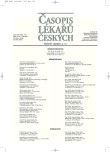-
Medical journals
- Career
Laparoscopic Radical Nephrectomy – The Cohort of 150 Patients
Authors: V. Eret 1; M. Hora 1; J. Klečka 1; P. Stránský 1; J. Ferda 2; O. Hes 3; T. Ürge 1
Authors‘ workplace: Urologická klinika LF UK a FN, Plzeň 1; Radiodiagnostická klinika LF UK a FN, Plzeň 2; Šiklův patologicko-anatomický ústav LF UK a FN, Plzeň 3
Published in: Čas. Lék. čes. 2007; 146: 758-762
Category: Original Article
Overview
Background.
Minimally invasive surgery has been performing in the treatment of renal cancer at the Department of Urology in Plzeň since January 2003. We want to present and evaluate our results of laparoscopic nephrectomy (LRN) in the cohort of 150 patients.Methods and Results.
In our institution, 150 LRNs were performed in the period between January 2003 and April 2007, 145 of them transperitoneally and 5 retroperitoneally. These 150 LRNs were completed by 4 different surgeons. We use four trocars in a rhombus disposition for left-sided LRN, we add fifth port for liver elevation for right-sided LRN. We place four ports for retroperitoneoscopical LRN. Renal vessels are sectioned either separately with lockable clips or with endoGIA stapler en bloc. After mobilization of the kidney, it is inserted into the endobag and extracted through the extended incision after the 12 mm port in lower abdomen using splitting incision. 73 right and 77 left LRN were performed in our patients cohort. The mean age of patients was 62.5±10.2 (range 33.9–84.6) years. The mean operation time was 138±44 (55–270) minutes. The mean size on CT was 54.3±15.1 (29–101) mm. The mean hospitalization time was 6.1±2 (3–15) days. Adrenalectomy was performed in 16 patients, cholecystectomy in 4 patients and appendectomy in 3 patients. Per - operative complications appeared in 5 cases (3 %). Post - operative complications appeared in 7 patients (5 %). We can not evaluate own oncological results because of short-time follow-up.Conclusions:
LRN has become a new gold standard in the treatment of kidney tumours T1 (to 7 cm) and it represents an important approach in the treatment of kidney tumours in our institution. We highly recommend preoperatively biphasic CT angiography because it shows the exact number and topography of renal vessels. We prefer transperitoneal approach because of the larger working space and better topographical orientation. Patients profit from advantages of miniinvasivity mainly due to the faster return to the normal life. To the main disadvantages of this technique belong the higher technical demands on the operator and a higher prize of the procedure compared to the open operation.Key words:
renal cancer, minimally invasive surgical procedure, laparoscopy, nephrectomy.
Labels
Addictology Allergology and clinical immunology Angiology Audiology Clinical biochemistry Dermatology & STDs Paediatric gastroenterology Paediatric surgery Paediatric cardiology Paediatric neurology Paediatric ENT Paediatric psychiatry Paediatric rheumatology Diabetology Pharmacy Vascular surgery Pain management Dental Hygienist
Article was published inJournal of Czech Physicians

-
All articles in this issue
- New Aspects in Prostate Cancer Therapy
- Radical Cystectomy in the Treatment for Bladder Carcinoma: Results of 125 Operated Patients
- Cystectomy in the Treatment of Bladder Cancer
- Laparoscopic Radical Nephrectomy – The Cohort of 150 Patients
- Carcinoma of the Penis
- Controversial Opinions in the Prostate Cancer Treatment
- Comparison of the Efficacy of ESWL and Ureteroscopy in the Treatment of Lower Ureteric Stone
- Long-term Results of Uretroplastic Operations Using Buccal Mucosa in Different Modifications
- Detection of Prostate Cancer by Ultrasonographically-guided Transrectal Prostate Biopsies at the Department of Urology of the First Faculty of Medicine, Charles University and General Teaching Hospital in Prague, Analysis of 1464 Cases
- Evaluation of the Tumor Extension Before Planned Radical Prostatectomy: A Prospective Study
- Painful Bladder Syndrome in Interstitial cystitis: Relation Between Symptoms, Endoscopy and Biopsia Results and the Treatment Effects
- Progress of Laparoscopic Surgery in Adults at the Department of Urology of the First Faculty of Medicine and General Teaching Hospital
- Analyse of Results of Percutaneous Nephrolithotomies
- Conservative Treatment of the Traumatic Neurogenic Bladder Dysfunction
- Endoscopic and Conservative Treatment of Vesicoureteric Reflux
- Microsurgical Subinguinal Varicocelectomy in Children and Adolescents
- Journal of Czech Physicians
- Journal archive
- Current issue
- Online only
- About the journal
Most read in this issue- Painful Bladder Syndrome in Interstitial cystitis: Relation Between Symptoms, Endoscopy and Biopsia Results and the Treatment Effects
- Microsurgical Subinguinal Varicocelectomy in Children and Adolescents
- Long-term Results of Uretroplastic Operations Using Buccal Mucosa in Different Modifications
- Radical Cystectomy in the Treatment for Bladder Carcinoma: Results of 125 Operated Patients
Login#ADS_BOTTOM_SCRIPTS#Forgotten passwordEnter the email address that you registered with. We will send you instructions on how to set a new password.
- Career

